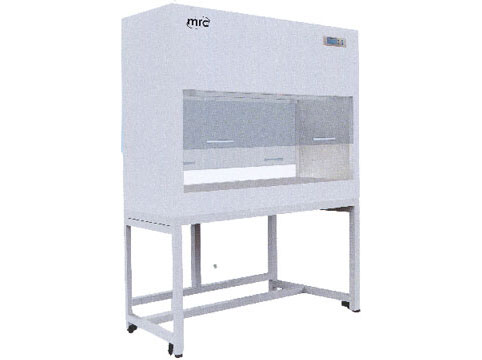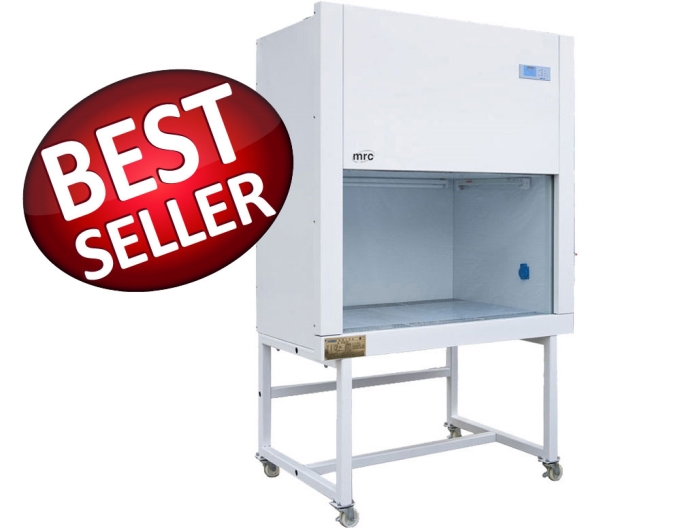A laminar flow hood is equipment that uses laminar airflow to protect lab samples and equipment from contamination. Laminar flow hoods are used in various settings, including medical laboratories, pharmaceutical manufacturing facilities, and food processing plants.
It is designed for the aseptic distribution of specific media and plate pouring in microbiological laboratories. The exhaust air is sucked into the face of the user by a strong blower in a laminar flow cabinet. The laminar flow hood provides an unobstructed, continuous flow of HEPA-filtered air across the work surface. Laminar Flow Hoods only protect the sample, not the user. Laminar flow hood is also called Clean Benches
Types Of Laminar Flow Cabinet
There are two types of laminar flow cabinets:
Vertical Laminar Flow Cabinet:
In a vertical laminar flow cabinet, the HEPA filter is located at the top of the cabinet, and the airflow is directed downwards. This type of cabinet is typically used for tasks that require more height, such as tissue culture or plant propagation. It is also considered safer because it reduces the chance of cross-contamination since airborne particles are less likely to escape from the work area.
Horizontal Laminar Flow Cabinet:
In a horizontal laminar flow cabinet, the HEPA filter is located at the side of the cabinet, and the airflow is directed horizontally. This type of cabinet is typically used for tasks that require less height, such as bacteria culture or media preparation. The eluent air flow directly hits the operator, so any chance of cross-contamination is high.
Construction Of Laminar Flow Hood
Laminar flow hood usually contains the following parts:
Cabinet:
The purpose of the cabinet is to protect the user and the sample from outside contaminants. The cabinet is made of smooth, non-porous material that can be easily cleaned and sterilized. It's usually made of stainless steel with fewer or no gaps or joints, and the front of the cabinet is made of a glass shield.
Working Station:
The working station is where the user performs tasks such as handling lab samples or equipment. It is typically located in the center of the cabinet and is surrounded by a continuous flow of filtered air. Culture plates, burners, and loops are placed on the workstation.
HEPA Filter:
The HEPA filter is located at the top of the cabinet and removes contaminants from the air before it enters the working station. You must replace the HEPA filter regularly to maintain its efficiency.
Filter Pad/ Pre-Filter:
The filter pad/ pre-filter is located below the HEPA filter and helps to extend the life of the HEPA filter by trapping larger particles. The filter pad/ pre-filter must be replaced regularly.
UV Lamp:
The UV lamp is located inside the cabinet and helps to sterilize the air inside the cabinet. The UV lamp must be turned on for a specific time before use and should be turned off when not in use. It needs to be turned on 15 minutes before the operation.
Fluorescent Lamp:
The fluorescent lamp is located at the top of the cabinet and helps to illuminate the working station.
Blower:
The blower is located at the back of the cabinet and produces the airflow that passes through the HEPA filter and into the working station.
Applications Of Laminar Flow Hoods
Laminar flow hoods are used in a variety of settings, including:
1.Hospitals: Laminar flow hoods are used in hospitals to protect patients from infection. They are often used in operating rooms and Intensive Care Units (ICUs).
2. Pharmaceutical industry: Laminar flow hoods are used in the pharmaceutical industry to protect drugs and chemicals from contamination. They are used in research and development laboratories.
3. Food industry: Laminar flow hoods are used in the food industry to protect food from contamination. They are regularly used in restaurants, grocery stores, and food processing plants.
4. Electronics industry: Laminar flow hoods are used in the electronics industry to protect electronic components from contamination. They are often used in manufacturing and assembly plants.
5. Cleanrooms: Laminar flow hoods are used in cleanrooms to protect sensitive equipment from contamination. They are often used in semiconductor fabrication facilities.
Wrapping Up
In conclusion, laminar flow hoods are an important tool in many industries and settings. They provide a sterile work environment that protects against contamination. Laminar flow hoods are easy to operate and maintain with regular cleaning and replacement of filters. If you have any questions or comments, please contact us. Thank you for reading!
Best Laminar Flow Hood
1.
VERTICAL LAMINAR FLOW CABINET-DOUBLE SIDE WORK BENCH
2~4 Operators can work together
External size (W*D*H): 1440*660*1770mm
Internal size (W*D*H): 1340*560*545mm
Work surface height: 750mm
Display: LED
Air flow velocity: Average of 0.3-0.5m/s

2.
LAMINAR FLOW CABINET HORIZONTAL FLOW, 1000MM LENGTH
This model doesn't have a front sash!!
External Size(W*D*H): 1100*808*1690mm
Internal Size(W*D*H): 1000*500*600mm
Work Surface Height: 750mm
Display: LCD Display
Airflow Velocity: Average of 0.30~0.45m/s

3.
LAMINAR FLOW CABINET VERTICAL FLOW, 940MM LENGTH
 LED display.
LED display.
External Size (W*D*H), mm: 1040x615x1770
Internal Size (W*D*H), mm: 940x540x545
Work Surface Height: 750mm
Display: LED Display
Airflow Velocity
